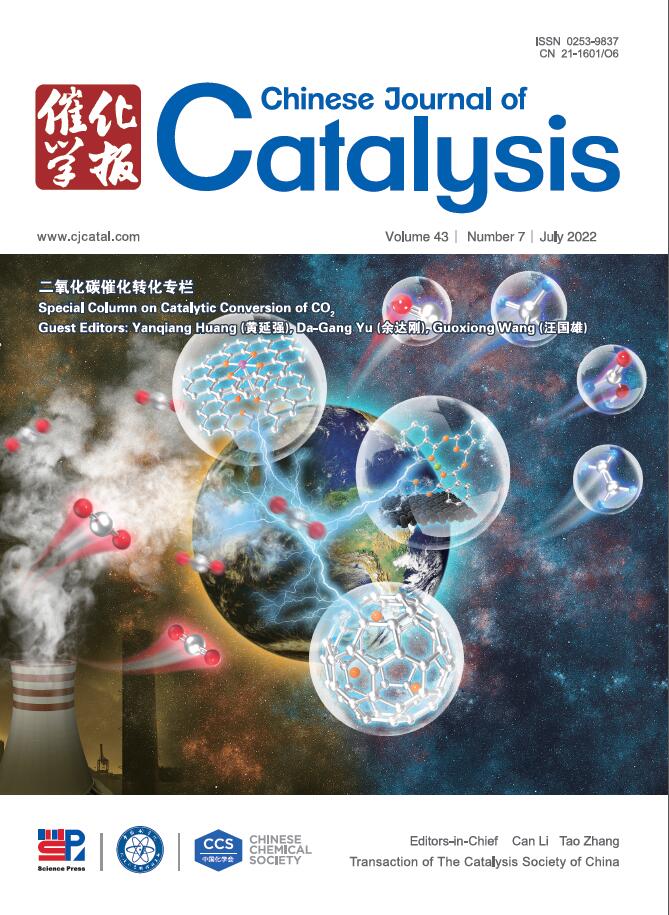The role of C1 species in the methanol-to-hydrocarbons reaction: Beyond merely being reactants
IF 15.7
1区 化学
Q1 CHEMISTRY, APPLIED
引用次数: 0
Abstract
In the methanol-to-hydrocarbons (MTH) process, C1 species, including methanol, dimethyl ether, and surface methoxy species (SMS), play crucial roles in the evolution of organic species and the construction of reaction networks. Understanding the roles of C1 species throughout the entire MTH process is both essential and challenging. Herein, the dynamic evolution of organic species and unique variation of C1 species during the real-time MTH process were observed by operando diffused reflectance Fourier transform infrared spectroscopy and ex-situ 13C cross polarization/magic-angle spinning nuclear magnetic resonance experiments. Importantly, density functional theory calculations thoroughly illustrated that methanol and SMS serve as key C1 species, in the form of not only methylation agents but also hydride acceptors, and their contributions vary across different reaction periods. Initially, SMS acts as the preferential C1 surface intermediate, methylating with hydrocarbons to propagate C–C bond, while also accepting hydrides to generate precursors for active hydrocarbon pool species. As reaction progresses, the role of SMS gradually diminishes, and thereby methanol becomes the predominant C1 species, in methylation for efficient product formation, meanwhile in hydride-transfer causing catalyst deactivation. Additionally, it was demonstrated that the confined zeolite microenvironment modified by large organics affects methanol adsorption and SMS formation, also accounting for the absence of SMS during the later period of reaction. This work provides a comprehensive and systematic understanding of the dynamic roles of C1 species throughout the MTH process, beyond the role as reactants.
C1在甲醇制烃反应中的作用:不仅仅是作为反应物
在甲醇制烃(MTH)过程中,C1类物质,包括甲醇、二甲醚和表面甲氧基类物质(SMS),在有机物质的进化和反应网络的构建中起着至关重要的作用。了解C1在整个MTH过程中的作用既是必要的,也是具有挑战性的。利用operando漫反射傅里叶变换红外光谱和离地13C交叉极化/魔角旋转核磁共振实验,观察了实时MTH过程中有机物种的动态演化和C1物种的独特变化。重要的是,密度泛函理论计算充分说明了甲醇和SMS作为关键的C1物质,不仅以甲基化剂的形式存在,而且以氢化物受体的形式存在,并且它们的贡献在不同的反应时期有所不同。最初,SMS作为首选的C1表面中间体,与碳氢化合物甲基化以繁殖C-C键,同时也接受氢化物以生成活性烃池物种的前体。随着反应的进行,SMS的作用逐渐减弱,甲醇成为主要的C1物质,在甲基化过程中形成高效的产物,同时在氢化物转移过程中导致催化剂失活。此外,大体积有机物修饰的密闭沸石微环境影响甲醇吸附和SMS的形成,也解释了反应后期没有SMS的原因。这项工作提供了C1物种在整个MTH过程中的动态作用的全面和系统的理解,超出了作为反应物的作用。
本文章由计算机程序翻译,如有差异,请以英文原文为准。
求助全文
约1分钟内获得全文
求助全文
来源期刊

Chinese Journal of Catalysis
工程技术-工程:化工
CiteScore
25.80
自引率
10.30%
发文量
235
审稿时长
1.2 months
期刊介绍:
The journal covers a broad scope, encompassing new trends in catalysis for applications in energy production, environmental protection, and the preparation of materials, petroleum chemicals, and fine chemicals. It explores the scientific foundation for preparing and activating catalysts of commercial interest, emphasizing representative models.The focus includes spectroscopic methods for structural characterization, especially in situ techniques, as well as new theoretical methods with practical impact in catalysis and catalytic reactions.The journal delves into the relationship between homogeneous and heterogeneous catalysis and includes theoretical studies on the structure and reactivity of catalysts.Additionally, contributions on photocatalysis, biocatalysis, surface science, and catalysis-related chemical kinetics are welcomed.
 求助内容:
求助内容: 应助结果提醒方式:
应助结果提醒方式:


